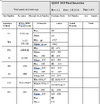Hello Everyone,
I am curious how others handle supplying Inspection reports, specifically when the order is fulfilled from stock reserves.
When required by PO we send out an inspection report with the max and min of measurements recorded from our sample. The form states the required info per AS9102 (part number, name, revision ETC), this includes a PO number. The PO number is my issue, as when completing the inspection report for the original contract the PO number references that contract, as it should. However, sometimes on following orders we have remaining parts in stock from the original order, seeing as though those parts were accepted on the original sampling plan, we do not reinspect. so no need to change the form, other than the PO number listed no longer references the current contract.
I have not had anyone complain about this but it seems like it could cause confusion. Our certificate of conformance states which reports apply to the particular parts and our production routing can be traced to show this.
Does anyone have a better solution?
Thanks
I am curious how others handle supplying Inspection reports, specifically when the order is fulfilled from stock reserves.
When required by PO we send out an inspection report with the max and min of measurements recorded from our sample. The form states the required info per AS9102 (part number, name, revision ETC), this includes a PO number. The PO number is my issue, as when completing the inspection report for the original contract the PO number references that contract, as it should. However, sometimes on following orders we have remaining parts in stock from the original order, seeing as though those parts were accepted on the original sampling plan, we do not reinspect. so no need to change the form, other than the PO number listed no longer references the current contract.
I have not had anyone complain about this but it seems like it could cause confusion. Our certificate of conformance states which reports apply to the particular parts and our production routing can be traced to show this.
Does anyone have a better solution?
Thanks

